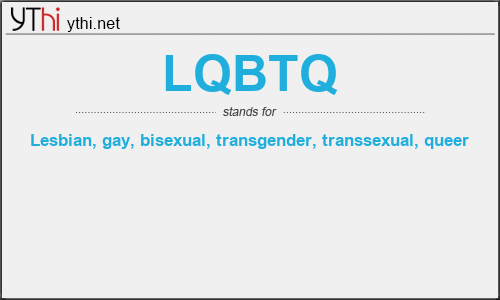What does LQBTQ mean? What is the full form of LQBTQ?
The Full Form of LQBTQ is Lesbian, gay, bisexual, transgender, transsexual, queer.
Lesbian
A lesbian is a female homosexual: a female who experiences romantic love or sexual attraction to other females.
Gay
Gay is a term that primarily refers to a homosexual person or the trait of being homosexual. Gay is often used to describe homosexual males but lesbians may also be referred to as gay.
Bisexual
Bisexuality is romantic attraction, sexual attraction or sexual behavior toward both males and females, or romantic or sexual attraction to people of any sex or gender identity; this latter aspect is sometimes termed pansexuality.
Transgender
Transgender is an umbrella term for people whose gender identity differs from what is typically associated with the sex they were assigned at birth. It is sometimes abbreviated to trans.
Transsexual
experience a gender identity inconsistent or not culturally associated with the sex they were assigned at birth.
Queer
Queer is an umbrella term for sexual and gender minorities that are not heterosexual or cisgender. Queer was originally used pejoratively against those with same-sex desires but, beginning in the late-1980s, queer scholars and activists began to reclaim the word.
Ally: A person who is not LGBTQ but shows support/ promotes equality in a variety of ways.
Androgynous: Identifying and/or presenting as neither distinguishably masculine nor feminine.
Agender: Having no gender
Asexual (Ace) : The lack of a sexual attraction or desire for other people. There are degrees of asexuality, such as demisexual (emotional/romantic attraction needed) and graysexual (variable)
Biphobia: Prejudice, fear, or hatred directed toward bisexual people.
Bisexual: A term that describes someone who is attracted to both men and women, or to more than one gender identity.
Cisgender or Cis : A term used to describe a person whose gender identity aligns with those typically associated with the sex assigned to them at birth.
Gay: A person who is emotionally, romantically or sexually attracted to members of the same gender. Also used to refer to men who are attracted to men.
Gender dysphoria: Clinically significant distress caused when a person’s assigned birth gender is not the same as the one with which they identify.
Gender-expansive: Conveys a wider, more flexible range of gender identity and/or expression than typically associated with the binary gender system. See also non-binary.
Gender expression: External appearance of one’s gender identity, usually expressed through behavior, clothing, haircut or voice, and which may or may not conform to socially defined behaviors and characteristics typically associated with being either masculine or feminine.
Gender-fluid: A person who does not identify with a single fixed gender; of or relating to a person having or expressing a fluid or unfixed gender identity.
Gender identity: One’s innermost concept of self as male, female, a blend of both or neither–how individuals perceive themselves and what they call themselves. One’s gender identity can be the same or different from their sex assigned at birth.
Gender non-conforming: A broad term referring to people who do not behave in a way that conforms to the traditional expectations of their gender, or whose gender expression does not fit neatly into a category.
Genderqueer: Genderqueer people typically reject notions of static categories of gender and embrace a fluidity of gender identity and often, though not always, sexual orientation. People who identify as “genderqueer” may see themselves as being both male and female, neither male nor female or as falling completely outside these categories.
Heteronormativity: The assumption that heterosexuality is the norm; usually with traditional gender assumptions of masculinity and femininity.
Heterosexism: Prejudice for or discrimination against homosexual or queer people; practices favoring heterosexuality
Homophobia: The fear and hatred of or discomfort with people who are attracted to members of the same sex.
Intersex: Describes a condition in which a person is born with a sex that doesn’t fit the typical definitions of female or male due to genetic, hormonal or anatomical differences.
Lesbian: A woman who is emotionally, romantically or sexually attracted to other women.
LGBTQ: An acronym for “lesbian, gay, bisexual, transgender and queer.” Q also=questioning.
Non-Binary (NB or enby): Anything that falls outside of the binary system (see definition above). Intersex, genderqueer, and bisexuality are all examples of non-binary identities.
Pansexual: Describes someone who has the potential for emotional, romantic or sexual attraction to people of any gender though not necessarily simultaneously, in the same way or to the same degree. Seen to be more inclusive than bisexual, which some argue implies a binary.
Queer: A term people often use to express fluid identities and orientations. Often used interchangeably with “LGBTQ.”
Questioning: A term used to describe people who are in the process of exploring their sexual orientation or gender identity.
Same-gender loving: A term some prefer to use instead of lesbian, gay or bisexual to express attraction to and love of people of the same gender. “Woman-loving woman” (WLW) or “Man-loving man” (MLM) are also used in online communities.
Sexual orientation: An inherent or immutable enduring emotional, romantic or sexual attraction to other people.
Transitioning: The social, legal, and/or medical process a trans* person may go through to make their gender identity fit their gender expression, presentation, or sex. This word means many different things to different people and is not all-or-nothing.
Transgender (Trans*): An umbrella term for people whose gender identity and/or expression is different from cultural expectations based on the sex they were assigned at birth. Does not imply any specific sexual orientation.
Transphobia: The fear and hatred of, or discomfort with, transgender people.
LQBTQ
means
Lesbian, gay, bisexual, transgender, transsexual, queer![]()
Translate Lesbian, gay, bisexual, transgender, transsexual, queer to other language.


Leave a Reply
You must be logged in to post a comment.